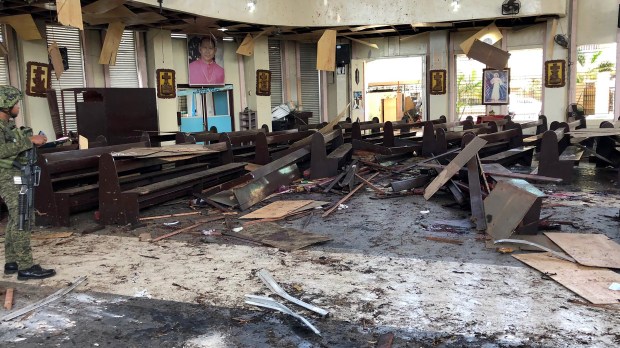As the Islamic State group, once the terror of Christians in the Middle East, seems to be receding from Syria and Iraq, could their new stronghold now be in the South Pacific?
The New York Times reported today that the black flag of the Islamic State is “flying over what the group considers its East Asia province”—in the southern Philippines.
“Men in the jungle, two oceans away from the arid birthplace of the Islamic State, are taking the terrorist brand name into new battles,” the Times said.
The most dramatic evidence for this new threat seems to be the bombing of the Cathedral of Our Lady of Mount Carmel in Jolo during Sunday Mass January 23. Two bombs went off at the church, killing 23 people. “The Islamic State claimed a pair of its suicide bombers had caused the carnage,” the Times said.
Several days later, an illustration emerged on Islamic State chat groups that seemed to taunt the Philippines’ combative president, Rodrigo Duterte. The drawing depicted Duterte kneeling on a pile of skulls with a militant standing over him with a dagger.
“The fighting has just begun,” read the caption.
The Mindanao island group of the southern Philippines has long been a haven for insurgents because of dense wilderness and weak policing, the Times explained. Now, the Islamic State has attracted a range of militant jihadists there, even as U.S. President Donald J. Trump has been crowing that there will soon be no trace left of ISIS in Syria, where an American-led campaign has gradually reduced the caliphate’s territory from a Britain-sized swath of land to a holdout village.
Some experts all along have cautioned that, even if ISIS is defeated in the battlefield, its ideology will perdure, either simmering beneath the surface in postwar Iraq and Syria or sprouting in reincarnations elsewhere, carried to other countries by former fighters or inspiring homegrown terrorists.
“Boko Haram has territorial ambitions and is evolving into the Islamic State of West Africa Province, manifesting a desire to have their own expanded Islamic country,” Nigerian Archbishop Ignatius Kaigama said at the United Nations this month.
But ISIS first made a big push for southern Philippines recruitment in 2016, the Times said, circulating videos online beckoning militants who could not travel to Iraq and Syria:
Hundreds of fighters poured in from as far away as Chechnya, Somalia and Yemen, intelligence officials said. The next year, militants who had pledged allegiance to the Islamic State took over the city of Marawi in Mindanao. By the time the army prevailed five months later, the largest Muslim-majority city in the country lay in ruins. At least 900 insurgents were killed, including foreign fighters and Isnilon Hapilon, the Islamic State’s East Asia emir.
“ISIS has a lot of power,” Motondan Indama, a former child fighter on the island of Basilan, told the Times.
Rommel Banlaoi, chairman of the Philippine Institute for Peace, Violence and Terrorism Research, opined that ISIS is the “most complicated, evolving problem for the Philippines today, and we should not pretend that it doesn’t exist.”
Since the cathedral bombing in January, the Philippine military has responded with airstrikes and 10,000 soldiers in Jolo, according to a military spokesman. But some say the investigation of the bombing, which blamed the local insurgent group Abu Sayyaf, ignored the threat from ISIS.
“We are asking for an independent investigation because it was too quick, too soon to say it’s a closed case,” Fr. Jefferson Nadua, a parish priest, told the Times. “This is a serious matter that needs to be looked at more deeply because the threat is not just local. It’s maybe coming from outside, from ISIS.”

